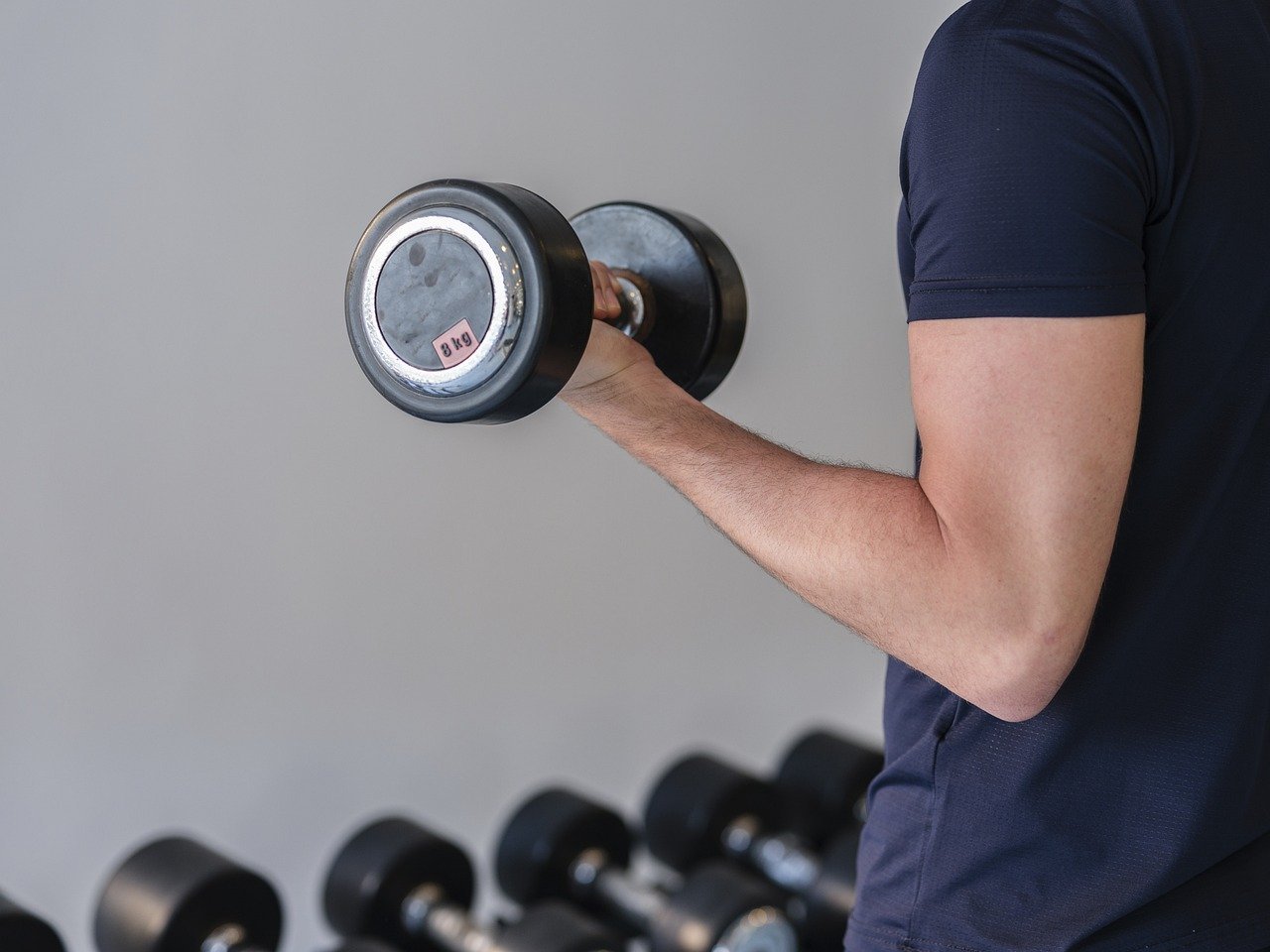Did you know 75% of people who exercise like doing it at home? This shows how popular home workouts are becoming. You can reach your fitness goals from your own space. The right home workout can give you fitness benefits without needing a gym.
Adding a home workout to your day can be super convenient. It’s effective and versatile, fitting anyone’s needs. Whether you’re new to working out or have been doing it for years, a good home routine can help you achieve your goals. It boosts your health, energy, and mental focus.
Key Takeaways
- You can achieve your fitness goals with a well-structured home workout routine
- Home-based fitness and exercise can be more convenient and cost-effective than gym memberships
- The best workout routines are tailored to your needs and goals
- Home workouts can be adapted to fit your lifestyle and schedule
- Incorporating a home workout into your daily routine can improve your overall health and wellbeing
- You can experience the benefits of fitness and exercise from the comfort of your own home
Understanding the Benefits of Home Fitness and Exercise
Starting at-home fitness can change your health and fitness path. A home gym brings benefits that regular gyms can’t match.
Time and Cost Efficiency
Having a home gym saves you time on travel. It also cuts down on monthly costs. Here’s a quick look at the savings:
| Expense | Traditional Gym | Home Gym |
|---|---|---|
| Initial Setup | $50-$100/month | One-time $300-$1000 |
| Monthly Fees | $50-$100 | $0 |
| Time Commuting | 30 minutes each way | 0 minutes |
Privacy and Convenience
Working out at home means privacy. You can set your own schedule. This makes it easier to keep up with your fitness goals.
Sustainable Lifestyle Integration
Adding at-home fitness to your daily life is key. It makes staying fit a natural part of your routine. This boosts your health and fitness without disrupting your life.
Essential Components of an Effective Home Workout
To make a great home workout, mix different workout routines. This includes cardio, strength training, and flexibility exercises. Each one helps in a unique way to improve your fitness.
- Cardio: Running in place or jump rope boosts heart health and stamina.
- Strength Training: Using resistance bands or dumbbells helps build muscle strength and tone.
- Flexibility: Stretching exercises improve mobility and lower injury risk.
It’s key to keep the right form to avoid injuries and get the most out of your workout. Sticking to a routine helps you see lasting results. Also, make your exercises harder over time to keep improving.
Here are some workout tips to blend these elements:
- Plan a regular schedule to stay on track.
- Keep an eye on your progress to stay motivated.
- Vary your exercises to keep workouts fun and interesting.
| Component | Description | Example Exercises |
|---|---|---|
| Cardio | Boosts heart health and stamina. | Jumping jacks, burpees, high knees |
| Strength Training | Increases muscle mass and metabolism. | Push-ups, squats, resistance band curls |
| Flexibility | Enhances range of motion and reduces muscle tension. | Yoga poses, static stretching, Pilates |
Creating Your Ideal Workout Space
Turning a part of your home into a workout area boosts your fitness journey. A well-thought-out space can keep you motivated and make your workouts better.
Space Requirements
First, figure out how much space you have at home. You might have a spare room, garage section, or a part of your living area. Make sure it’s big enough for your gear and for moving around. Having enough space lets you do different workouts without feeling stuck.
Flooring Considerations
Choosing the right floor is key for comfort and protecting your equipment. Think about using interlocking foam tiles or rubber flooring. They absorb shock and keep noise down. Plus, they protect your floors from heavy weights and equipment, keeping them safe and lasting longer.
Ventilation and Lighting
Good air flow makes your workout area comfortable and fresh. Use fans or open windows for better air. Also, having enough light is important. Natural light can lift your mood, and adjustable artificial light lets you set the mood for any time.
Building Your Perfect Home Gym Setup
Creating an effective home gym starts with the right exercise equipment. Whether you’re new or upgrading, here are key options to think about.
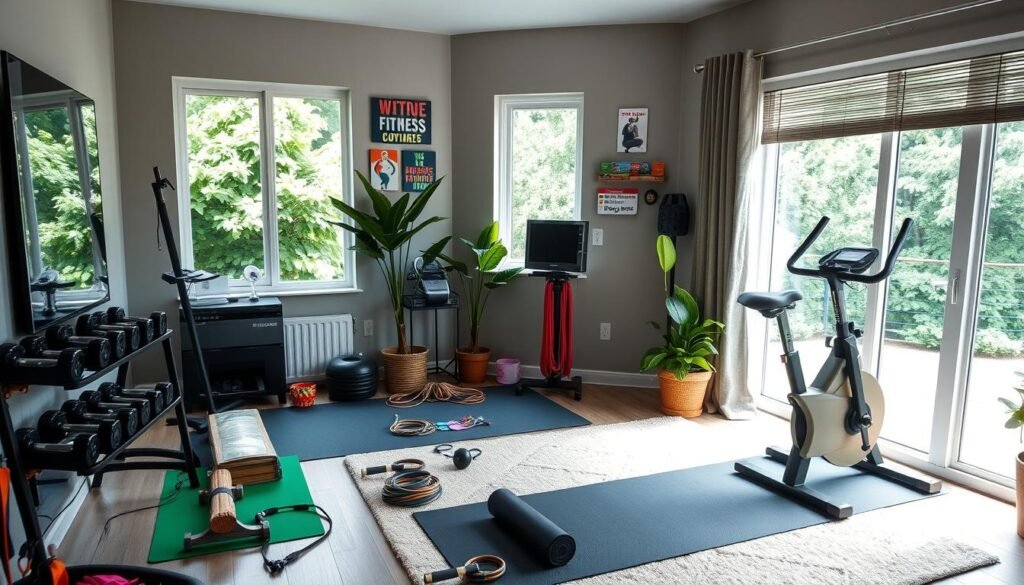
Basic Equipment Essentials
Start with the basics to cover different workout tips:
- Dumbbells: Great for strength training.
- Resistance Bands: Perfect for flexibility and strength.
- Yoga Mat: Comfortable for floor exercises and stretching.
Advanced Equipment Options
Looking to grow your home gym? Check out these advanced tools:
- Adjustable Bench: Boosts various weightlifting routines.
- Treadmill: Ideal for cardio.
- Kettlebells: Excellent for dynamic strength and endurance.
Budget-Friendly Alternatives
You can create a full gym without spending a lot. Here are some affordable exercise equipment choices:
- Used Equipment: Buy second-hand from trusted brands.
- DIY Weights: Use items like water bottles or canned goods.
- Minimalist Setup: Choose multi-purpose gear to save space and money.
With the right exercise equipment and planning, your home gym can be key to reaching your fitness goals.
Designing Your Best Workout Schedule
Creating a workout schedule is key to reaching your fitness goals. First, figure out how many days a week you can dedicate to exercise. Beginners should start with three to four days a week. This allows for enough rest and recovery.
Then, decide how long each workout should last. Aim for 30 to 60 minutes, based on your fitness level and schedule. Make sure to mix cardio, strength training, and flexibility exercises for a well-rounded routine.
- Frequency: 3-5 days per week to build consistency.
- Duration: 30-60 minutes per session for optimal results.
- Intensity: Vary your workout intensity to prevent burnout and promote improvement.
- Exercise Types: Combine different workouts such as HIIT, weightlifting, and yoga.
- Rest Days: Schedule rest days to allow your body to recover and grow stronger.
As you get better, increase the intensity or try new exercises. Keeping track of your progress helps you make adjustments. This ensures you stay challenged and avoid hitting a plateau.
| Day | Workout Routine | Duration | Intensity |
|---|---|---|---|
| Monday | Cardio (HIIT) | 30 mins | High |
| Tuesday | Strength Training (Upper Body) | 45 mins | Medium |
| Wednesday | Yoga and Flexibility | 30 mins | Low |
| Thursday | Cardio (Running) | 40 mins | Medium |
| Friday | Strength Training (Lower Body) | 45 mins | High |
| Saturday | Active Rest (Walking or Light Activity) | 30 mins | Low |
| Sunday | Rest Day | — | — |
Bodyweight Exercises for Maximum Results
Enhancing your home workout doesn’t need fancy equipment. Use these effective bodyweight exercises for the best workout results.
Upper Body Movements
Strengthen your arms, chest, and shoulders with these exercises:
- Push-Ups: Keep your body straight and lower until your chest nearly touches the floor.
- Tricep Dips: Use a sturdy chair to target your triceps effectively.
- Pike Push-Ups: Focus on your shoulders by raising your hips towards the ceiling.
Core Strengthening Exercises
A strong core is vital for overall fitness. Try these routines:
- Planks: Maintain a straight line from head to heels, engaging your core.
- Bicycle Crunches: Alternate elbow to opposite knee for dynamic core activation.
- Leg Raises: Lift your legs while keeping your lower back pressed to the ground.
Lower Body Workouts
Build lower body strength with these movements:
- Squats: Keep your feet shoulder-width apart and lower your hips back.
- Lunges: Step forward and lower until both knees are at 90 degrees.
- Calf Raises: Stand on your toes to strengthen your calves.
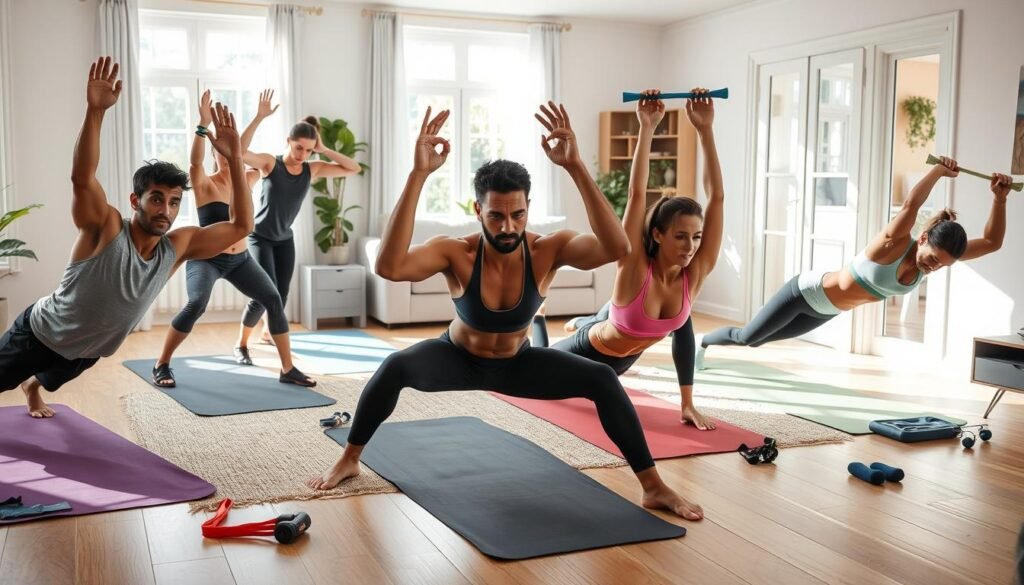
| Exercise | Target Area | Difficulty |
|---|---|---|
| Push-Ups | Chest, Arms | Beginner to Advanced |
| Planks | Core | Beginner |
| Squats | Legs, Glutes | Beginner |
| Pike Push-Ups | Shoulders | Intermediate |
| Bicycle Crunches | Core | Intermediate |
| Lunges | Legs | Beginner |
Equipment-Based Training Techniques
Make the most of your home gym by adding different exercise equipment to your workout routines. Each piece has its own benefits to help you get fit.
Here are some top training methods using common exercise equipment:
- Dumbbells: Great for building strength. Try bicep curls, shoulder presses, and lunges.
- Resistance Bands: Add tension without weights. Use them for assisted pull-ups, leg presses, and chest flyes.
- Kettlebells: Ideal for dynamic movements. Do kettlebell swings, goblet squats, and Turkish get-ups for power and endurance.
- Stability Balls: Improve core stability. Do ball crunches, planks, and back extensions.
Switching up these workout routines keeps your home gym sessions fun and tough.
| Exercise Equipment | Workout Routines | Benefits |
|---|---|---|
| Dumbbells | Bicep Curls, Shoulder Presses, Lunges | Strengthens muscles, increases flexibility |
| Resistance Bands | Assisted Pull-Ups, Leg Presses, Chest Flyes | Enhances muscle tone, improves mobility |
| Kettlebells | Kettlebell Swings, Goblet Squats, Turkish Get-Ups | Builds power, boosts cardiovascular fitness |
| Stability Balls | Ball Crunches, Planks, Back Extensions | Improves core stability, posture |
Cardio Workouts for Home Training
Adding cardio to your home workouts is key for heart health and fitness. Home workouts offer many options to keep your routine fun and effective.
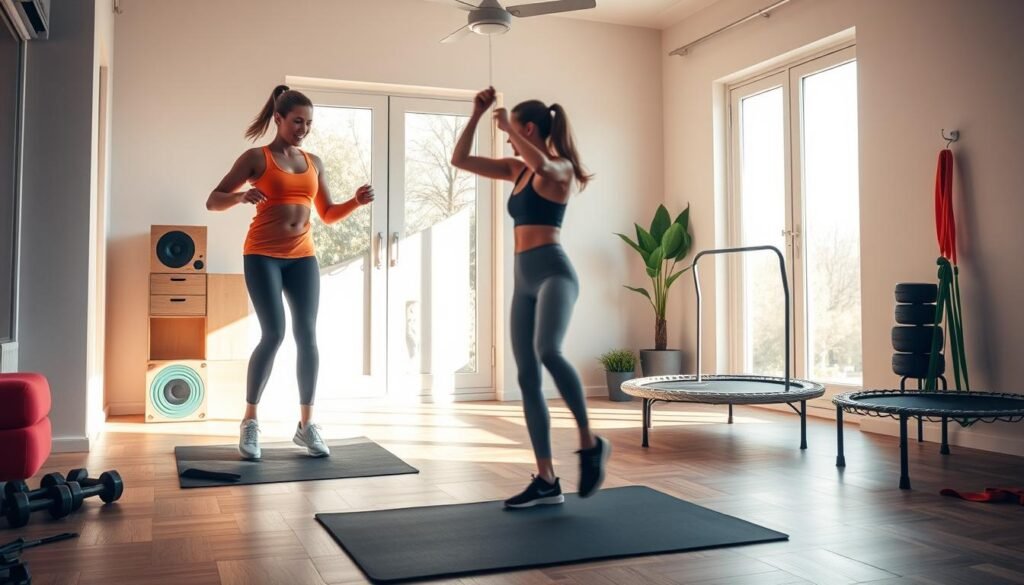
High-Intensity Interval Training (HIIT)
HIIT is great for quick, effective workouts. It mixes short, intense exercises with rest periods. A common HIIT routine might include:
- 30 seconds of jumping jacks
- 15 seconds rest
- 30 seconds of burpees
- 15 seconds rest
- Repeat for 20 minutes
This method burns calories fast and boosts heart health.
Low-Impact Cardio Options
Low-impact cardio is perfect for those with joint issues or who prefer easier exercises. It’s less stressful on the body but keeps your heart rate up. Try activities like:
- Walking or marching in place
- Cycling on a stationary bike
- Swimming or water aerobics if you have access to a pool
These options help keep you fit and healthy without the strain of high-impact exercises.
Equipment-Free Cardio Routines
You don’t need special gear for a good cardio workout. Simple moves can raise your heart rate and improve fitness. Try these:
- Mountain climbers
- High knees
- Shadow boxing
- Dance routines
These exercises are easy to do and can be tailored to your fitness level. This makes home workouts available to everyone.
Recovery and Rest Day Strategies
Recovery is key to your health and fitness routine. It lets your muscles fix and get stronger after hard workouts.
Make sure to include rest days in your workout tips. These breaks stop burnout and keep you motivated.
Try light yoga or walking for active recovery. They keep you moving without hurting your body, helping you reach your health and fitness goals.
Stretching makes you more flexible and less stiff. It gets you ready for your next best workout.
Use foam rolling for self-massage to ease soreness and boost blood flow. Also, focus on good sleep and nutrition to fuel your body and improve your health and fitness.
Tracking Progress and Making Adjustments
It’s key to track your fitness journey to get the best results. By watching your progress, you stay motivated. You also make smart choices to improve your routine.
Measuring Success
There are many ways to see how you’re doing:
- Body Measurements: Watch your weight, body fat, and muscle changes.
- Performance Metrics: See how your strength, endurance, and flexibility grow.
- Progress Photos: Photos show how your body looks different over time.
Adapting Your Routine
To avoid hitting a wall, change your workout often. You might do more intense workouts, try new moves, or change your schedule. This keeps your body challenged and improving.
Setting New Goals
Setting new goals keeps your fitness journey exciting. It pushes you to do better. Whether it’s lifting heavier, running faster, or learning a new yoga pose, new goals keep you going.
| Measurement Method | Description | Benefits |
|---|---|---|
| Body Measurements | Tracking weight, body fat, and muscle mass over time. | Provides concrete data on physical changes. |
| Performance Metrics | Monitoring strength, endurance, and flexibility improvements. | Highlights functional fitness gains. |
| Progress Photos | Taking regular photos to visualize changes. | Offers a visual representation of progress. |
Safety Tips and Injury Prevention
Your safety is key in any home workout. Start each session with a good warm-up. This prepares your muscles and helps avoid injuries.
Use workout tips like stretching and light cardio to get ready. After working out, cool down to help your muscles recover.
Make sure to do exercises correctly. Bad form can cause strains and injuries. If you’re not sure, check online tutorials or fitness apps for help.
Pay attention to your body to avoid overtraining. Take breaks often and don’t ignore pain. This helps keep you healthy and on track with your fitness goals.
Common injuries in home workouts include back pain, knee strain, and wrist discomfort. Avoid these by using the right equipment and keeping your workout area safe and clear.
- Warm up and cool down properly
- Use correct exercise form
- Listen to your body
- Maintain a safe workout environment
Maintaining Motivation for Long-Term Success
Staying committed to your fitness and exercise routine can be tough. Here are some tips to keep you going on your at-home fitness journey.
Building Healthy Habits
Start by adding small changes to your daily routine. Make fitness a natural part of your life. Set clear goals, stick to a workout schedule, and celebrate your wins.
Overcoming Common Obstacles
Time and lack of motivation can stop you. Treat workouts as appointments and find fun activities. Changing up your online workouts can also keep things interesting.
Finding Accountability
Being part of a fitness community or having a workout buddy helps a lot. Online workouts often have forums or group sessions. Here, you can share your achievements and stay motivated with others.
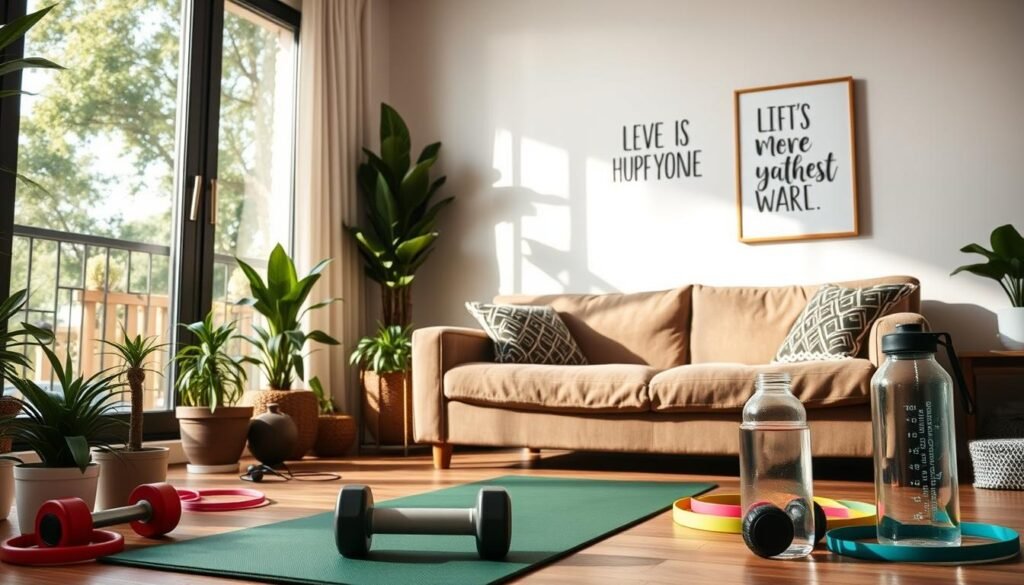
Conclusion
Starting a home workout routine can change how you see fitness. It lets you adjust workouts to fit your life and space. This way of exercising saves money and fits easily into your day.
Creating a good workout area, picking the right gear, and sticking to a routine helps you reach your fitness goals at home. It’s important to track your progress and tweak your routine to keep it interesting.
Staying safe and avoiding injuries is key to a long-lasting fitness journey. Building healthy habits and overcoming challenges keeps you on track. Start today and see the good changes a home workout can bring.



